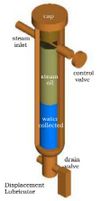Lubricator
Jump to navigation
Jump to search
Mechanical Lubricator
- Machining Lubricator Ratchet Wheels
- Van Brocklin Mechanical Lubricator
- Victor Shattock Mechanical Lubricator
- Turning Eccentrics in Three-Jaw Chuck
- Exploding view of Mechanical Lubricator for Doris by Jim Mullner
Displacement Lubricator
From "Steam 101 - Jargon Explained":
- A Displacement Lubricator is a very simple device for adding lubricating oil to the steam supply. They are not much to look at; just a vertical metal cylinder, closed top and bottom, and connected to the steam piping by a narrow tube near the top of the cylinder and include a valve in this tube. The valve allows you to add more oil while the engine is still running.
- The top of the cylinder unscrews, and you fill it with steam oil to just below the passageway in the small tube connected to the engine. With the cap replaced, you start the engine and open any valve in the small feed pipe. You then leave it alone to do its job, checking it from time to time until you learn how often it needs to be re-filled.
- Steam travels down the small pipe, and since the cylinder is sitting in the open, cooler air, the steam will condense back into a couple of droplets of water. Since oil is lighter than water, the water sinks to the bottom of the oil filled cylinder. The added water causes the oil level to rise above the bottom of the steam inlet tube, and a like number of drops of oil flow back through the tube, into the engine. The water has displaced the oil, giving the gadget its name.
- After the engine has been running a while, you will have to service the lubricator. You need to drain out the water that has collected, and top up the oil supply. If the lubricator has one, you close the valve in the inlet tube, without a valve, you will have to shut off the steam to your engine. Next you take the top off the lubricator. Before you can add more oil, you have to first open the drain valve at the bottom of the lubricator and let the water that has collected out. With the water gone, all that’s left is just to add a fresh supply of oil, and put the lubricator back into service.
References
- "Hydrostatic Lubricator", Live Steam by Father Finelli
- "Hydrostatic Lubricator", Chaski.org
- "Heavy Duty Mechanical Lubricator", Station Road Steam
- "Mechanical Lubricator", Wikipedia
- "Lubricators", Southern Steam Trains,
- Drawings for Mechanical and Displacement Lubricators, Bill Shields
- "Mechanical Lubricators", Chaski.org
- Mechanical Lubricator Plans
- "Displacement lubricator", Chaski.org
- "Elesco pump drawings", Chaski.org
- "What lubricator is this?", Chaski.org
- One-way needle bearing/clutch
- "Detroit Lubricators", Chaski.org
- "Mechanical Lubricator Ratchet Wheel", Chaski.org
- "Hydrostatic Oil", Chaski.org
